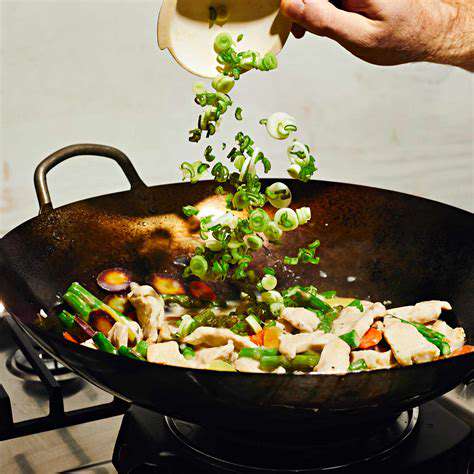Eating Habits in Scandinavia: Simple and Seasonal
Nordic cuisine, a reflection of the region's unique climate and resources, is a fascinating blend of fresh, seasonal ingredients and innovative culinary techniques. From the icy shores of Norway to the fertile lands of Denmark, the emphasis is on utilizing what's readily available, often resulting in dishes that are both incredibly flavorful and deeply connected to the land. This focus on sustainability and local sourcing is a defining characteristic of Nordic culinary culture, contributing to its growing global appeal.
The Nordic countries' proximity to the sea has heavily influenced their diets, with seafood playing a prominent role in many traditional dishes. Fresh fish, expertly prepared, is a staple across the region, showcasing the bounty of the North Atlantic.
The Impact of the Nordic Climate
The harsh, often unforgiving climate of the Nordic region has shaped the development of their culinary traditions. The short growing seasons necessitate a focus on hearty, winter-hardy vegetables and root crops, like potatoes, carrots, and turnips. This has led to a deep appreciation for preserving and fermenting ingredients to extend their availability throughout the year.
Furthermore, the long, dark winters have encouraged the development of comforting and flavorful dishes designed to nourish and sustain during the colder months. This emphasis on warmth and substance is a key element of Nordic culinary heritage.
The Importance of Fresh, Local Ingredients
Sustainability and the use of local, seasonal ingredients are paramount in Nordic cuisine. Farmers' markets are vibrant hubs of activity, showcasing the region's agricultural bounty. Chefs often partner with local producers to ensure the freshest, highest-quality ingredients are used in their creations.
This commitment to fresh, seasonal ingredients is not just a culinary trend but a cultural value. It reflects a deep respect for the environment and a desire to connect with the natural world surrounding them.
Beyond the Basics: Modern Interpretations
While traditional Nordic dishes remain cherished, modern chefs are pushing the boundaries of the culinary landscape by incorporating innovative techniques and global influences. This fusion of tradition and modernity has led to a contemporary Nordic cuisine that is both familiar and exciting.
The Role of Meat and Game in Nordic Dishes
Though seafood is a cornerstone, meat and game play a significant role in Nordic cuisine, particularly in areas with extensive forests and hunting traditions. Venison, reindeer, and wild boar are often featured in hearty stews and roasts, showcasing the region's rich hunting heritage.
These dishes often feature robust flavors and hearty textures, reflecting the need for sustenance in the Nordic climate. Preparation methods vary, but the focus is almost always on maximizing the flavor and nutritional value of the ingredients.
Regional Variations and Culinary Delights
Despite shared cultural roots, distinct regional variations in Nordic cuisine exist. For example, the coastal regions of Norway and Denmark have a strong emphasis on seafood, while the interior regions often highlight game and hearty stews. Exploring the regional variations provides a deeper appreciation for the diverse culinary tapestry of the Nordic countries.
Discovering the unique dishes of each region is a journey through the heart of Nordic culture, offering an authentic glimpse into the unique flavor profiles and culinary traditions of each country.

Simple Preparation Techniques
Simple Ingredient Selection
Scandinavian cuisine emphasizes fresh, seasonal ingredients. Farmers' markets are a cornerstone of the region's culinary scene, providing access to produce at its peak ripeness. This focus on readily available, high-quality ingredients minimizes the need for extensive preparation, allowing the natural flavors to shine through. Shopping lists are often tailored to the freshest available items, reflecting the rhythm of the seasons and ensuring optimal taste and nutritional value.
Choosing locally sourced ingredients not only supports local farmers but also ensures a lower environmental footprint. The emphasis on simplicity in preparation directly relates to the appreciation for natural flavors found in these fresh, seasonal products.
Utilizing Basic Cooking Methods
Simple cooking methods are prevalent in Scandinavian cuisine. Boiling, steaming, roasting, and sautéing are frequently employed, highlighting the inherent flavors of the ingredients without obscuring them with complex techniques. This approach allows the natural sweetness and earthiness of vegetables, the delicate tenderness of fish, and the robust richness of meat to be fully appreciated.
The focus on minimal manipulation of ingredients contributes to the healthy and wholesome nature of Scandinavian dishes. It’s about letting the natural qualities of the food speak for themselves.
Embracing Minimalist Flavors
Scandinavian cuisine often relies on a palette of subtle flavors, rather than overwhelming spice blends. Simple herbs like dill, parsley, and chives are frequently used to enhance the natural tastes of dishes. A touch of lemon juice or a drizzle of olive oil can elevate the overall flavor profile without detracting from the integrity of the ingredients.
This emphasis on subtle flavors reflects a deep appreciation for the pure essence of each ingredient. The goal is to enhance, not to mask, the natural tastes.
Quick and Easy Marinades
Marinades are a valuable tool for enhancing the taste and texture of proteins in Scandinavian cuisine. Simple marinades, often consisting of a few ingredients like lemon juice, herbs, and a touch of salt, can effectively tenderize meat and impart a delightful flavor.
These quick marinades are often prepared ahead of time, allowing the flavors to meld together and infuse the proteins without requiring extensive cooking time. This simplicity is a key component of the efficient and delicious nature of Scandinavian meals.
Savoring Seasonal Vegetables
Seasonal vegetables play a prominent role in Scandinavian meals. From vibrant spring asparagus to hearty autumn root vegetables, each season offers a unique array of fresh produce. These vegetables are often prepared simply, highlighting their natural sweetness and texture.
The abundance of fresh, seasonal vegetables in Scandinavia contributes to the healthy and sustainable nature of the cuisine. Utilizing the freshest produce available is a hallmark of this approach to eating.
The Art of Simple Sauces
While not overly complex, Scandinavian sauces often enhance the overall flavor of a dish. A simple vinaigrette, a creamy yogurt sauce, or a light reduction sauce can add depth and richness without masking the primary flavors of the main ingredients.
These sauces are often made with minimal ingredients and allow the natural flavors of the vegetables or protein to shine through. This approach to sauces is an important part of the overall simplicity of Scandinavian cooking.
Utilizing Leftovers Creatively
Scandinavian cuisine is known for its resourceful approach to utilizing leftovers. Simple techniques can transform yesterday's meal into a delicious and satisfying new dish. A hearty soup, a flavorful stew, or a simple salad can be easily adapted from yesterday's dinner, minimizing food waste and maximizing culinary creativity.
This practice of repurposing leftovers reflects a deep respect for food and an awareness of sustainability. It’s a practical and delicious way to embrace the philosophy of simple preparation.
Beyond the Basics: Embracing Regional Variations

Exploring Regional Variations
Regional variations in culinary traditions are a fascinating aspect of global food culture. These differences, often deeply rooted in local ingredients and historical influences, create a rich tapestry of flavors and textures. From the spicy curries of Southeast Asia to the hearty stews of Eastern Europe, regional cuisines reflect the unique environments and histories of their respective areas. Understanding these regional nuances enriches our appreciation for the diversity of food worldwide.
These variations aren't just about taste; they often reflect the unique agricultural resources available in a region. Certain ingredients become staples, shaping the very identity of a cuisine. For example, the prevalence of rice in Southeast Asia significantly impacts the types of dishes and cooking methods developed. This deep connection between food and environment is a key element in understanding regional culinary traditions.
The Role of History in Regional Cuisines
Historical events have profoundly shaped the development of regional cuisines. Migrations, trade routes, and political shifts have all played a part in introducing new ingredients and culinary techniques to different areas. The Silk Road, for instance, facilitated the exchange of spices and cooking methods across vast distances, leaving an indelible mark on the cuisines of numerous regions.
The history of colonization and empires also significantly influenced regional culinary traditions. Colonizers often brought their own ingredients and cooking styles, leading to the fusion of flavors and the creation of new dishes. The legacy of these interactions continues to be seen in many regions today, with dishes incorporating elements from both the colonizing and colonized cultures.
Regional Ingredients and Their Impact
The availability of specific ingredients is a defining factor in regional cuisines. The abundance of fresh seafood in coastal regions, for instance, often leads to dishes that are lighter, relying on fresh flavors and minimal preparation. Conversely, the availability of certain spices or grains in inland regions can significantly influence the types of dishes prepared.
The use of local produce in regional cuisine is critical to sustainability and cultural preservation. This reliance on readily available ingredients often results in dishes that are deeply connected to the environment and the people who live there. The unique characteristics of local ingredients, like specific types of rice, beans, or fruits, are essential in creating distinct regional flavors.
Regional Cooking Techniques
Different regions have developed unique cooking techniques that are deeply ingrained in their culinary traditions. The use of specific types of ovens, cooking vessels, and techniques like slow-cooking or grilling can significantly affect the final product. Understanding these techniques allows us to appreciate the unique approaches to food preparation in different parts of the world.
The level of importance placed on particular cooking methods often reflects the resources available and the cultural values of a region. For example, certain regions might prioritize techniques that maximize the use of seasonal ingredients, while others might focus on techniques that preserve food for longer periods. These regional differences in cooking techniques further contribute to the vast diversity of global food culture.
Preserving and Celebrating Regional Cuisines
Preservation of regional culinary traditions is crucial for cultural preservation and for fostering a deeper understanding of global heritage. Protecting these unique cuisines involves promoting the knowledge and skills of local chefs and food artisans, supporting local farmers who grow traditional ingredients, and sharing these culinary traditions with wider audiences. This involves more than just preserving recipes; it also includes preserving the stories and cultural significance behind the food.
Supporting local food businesses and farmers is vital to preserving regional cuisines and supporting local economies. By making conscious choices to support regional restaurants and farmers' markets, we directly contribute to the continued existence and evolution of these valuable traditions. Promoting the consumption of locally sourced and traditionally prepared foods is a powerful way to celebrate the diversity of regional culinary traditions.


![Best Mexican Restaurants in [City]](/static/images/28/2025-05/FineDiningMeetsMexicanFlair3AAnElevatedCulinaryExperience.jpg)







![Top Ice Cream Parlors in [City]](/static/images/28/2025-07/DiscoveringHiddenGemsandLocalFavorites.jpg)
